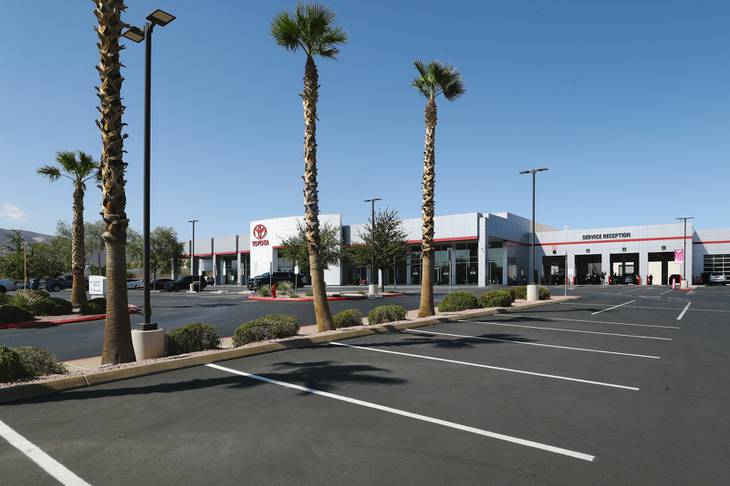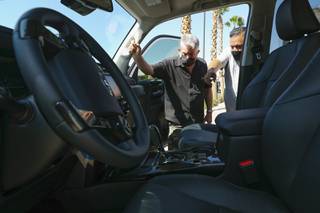While checking out a 2021 Toyota 4Runner Wednesday at a Henderson car lot, Dean Fitzgerald popped his head out of the SUV and paused.
“I don’t think I’ve ever seen a car lot this empty,” said Fitzgerald, a Henderson resident who was at Findlay Toyota to get his car serviced and was taking in the scene. “I guess it’s just like many other things during the pandemic, supply is short.”
In fact, according to Rolando Silva, the sales representative assisting Fitzgerald, the vehicle he was inspecting was one of only two new vehicles on the lot that day.
Normally, in nonpandemic times, Findlay Toyota at the Valley AutoMall would have about 900 new vehicles for customers to browse, said John Barr, the dealership’s general manager.
“It’s crazy,” Barr said. “I started selling cars in the city of Las Vegas in 1993 and I’ve never seen anything like this. I’ve never seen a shortage like this.”
To varying degrees, what’s happening these days at Findlay Toyota is being seen at most dealerships in the West and around the country.
One of the main culprits for the shortage of new car inventory is a lack of available semiconductor chips — which are so small, they can fit in the palm of your hand — needed to help new vehicles run. Global manufacturing of the chips slowed — and in some cases was halted completely — after the onset of the COVID-19 pandemic.
That caused a shortage in the automotive parts supply chain, a complex global network of manufacturers that make everything from the conductor chips to car stereos.
“We’re in a situation now where the chips are a big part of it, but there are other parts to this overall shortage,” Barr said. “There’s a shortage of oil and supplies needed to make seats, there’s a shortage with Pioneer stereos, and there’s all these cars being potentially built, but there are things missing.”
The manufacturers’ bottleneck has led to a price increase for both new and used cars. For July, auto industry analytics and data firm J.D. Power recorded an average new vehicle transaction price of $41,000, an all-time record.
When shopping for a new vehicle, consumers are finding they’ll likely have to wait several weeks — or even months — for delivery. They’ll also likely find fewer choices for both options, and find that dealer or manufacturer incentives are almost nonexistent.
Most of the new vehicles being sold across the country now are going for manufacturer’s suggested retail price, said Geno Effler, a J.D. Power spokesman.
The disruption to the new car pipeline has in turn caused an inflation of the used car market. Those interested in selling or trading in a used car are finding that their vehicle could be worth as much as $4,000 or $5,000 more than what it would normally be, Barr said.
“There’s never been a better time to trade your car in,” Barr said. “People have to have inventory to stay open. If we don’t have the new cars, we’re going to sell used cars. We’re always on the hunt for used vehicles.”
In July, Barr said, Findlay Toyota sold more than 800 vehicles. More than 500 were used vehicles.
Though it’s started to flatten, the average price for a used vehicle had gone up as much as 20% in some places since the onset of the pandemic last yearn, Effler said.
“There’s low supply, but there remains high demand for vehicles,” Effler said. “Dealers are staying away from incentives right now, so consumers aren’t getting as good of a deal as they would have pre-pandemic. On the used-car side, dealers are anxious to get any and every used vehicle they can.”
Because different carmakers do business with different auto industry parts suppliers, some dealerships have been able to better weather the supply chain challenges.
At Subaru of Las Vegas on Roy Horn Way, general manager Burton Hughes said inventory has been improving in recent weeks.
On June 1, only two new vehicles were on the lot. By mid-August, that number had swelled to about 60. During normal times, the dealership would likely have around 400 new cars on its lot.
“The chip shortage affects different manufacturers differently,” Hughes said Wednesday. “With us, you could call it preparation or maybe luck, but we’re in a better situation than some of the larger players in the market. The factories that supply us were only down for about two weeks when the pandemic first hit. Our lines are running at full speed now.”
But by Thursday the outlook at the dealership had changed dramatically. Hughes said he received news from Subaru headquarters that the supply of new cars to Subaru of Las Vegas would change dramatically. That’s because Toyota, which has an ownership stake in the Subaru brand, announced a 40% production cut.
That, Hughes said, will push back Subaru of Las Vegas’ allotment of new cars back at least a month.
In general, American consumers have become more accustomed to the digital shopping experience since the coronavirus pandemic began. Hughes said it’s been no different in the automotive industry.
Fewer vehicles on the lot, Hughes said, is likely to become the norm in the industry as consumers continue to move to digital buying. And when sitting around outside, vehicles can become damaged, often from weather conditions.
“Normally, a customer would expect to come to the dealership and see 30 examples of what they’re interested in buying,” Hughes said. “Now, they’re starting that process by researching and shopping online. Some customers aren’t even coming to the dealership at all before buying. There’s been a shift to digital retailing, though that’s been slower in the auto industry.”
As far as how long the new car inventory shortage will last, that’s anybody’s guess in the unpredictable times of COVID-19. Most experts — including those from J.D. Power and local dealerships in the Las Vegas Valley — said they expected it to spill into 2022.
“Sadly, this crunch is going to continue for the foreseeable future with many saying it won’t normalize for more than a year,” said Andrew MacKay, executive director of the Nevada Franchised Auto Dealers Association.
Back on the Findlay Toyota lot, Fitzgerald pondered what he might be able get in a trade for his 2019 4Runner, which he had brought in to be serviced. The white 2021 4Runner he was ogling would be a step up.
He hadn’t come to the dealership thinking of trading in his vehicle, but Silva, the salesman helping him, made it clear that he would likely get top dollar.
“I wasn’t aware that the market was like this,” Fitzgerald said. “These are interesting times to be living through.”

